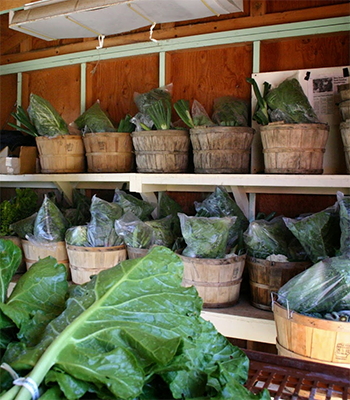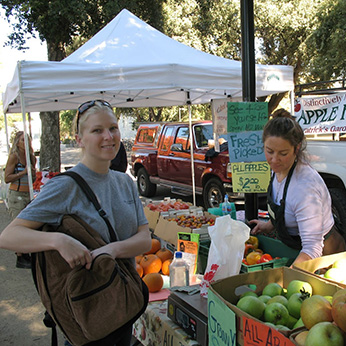
Direct marketing is the sale of agricultural goods and products from the farm straight to the consumer, without intervening distributors or retailers.
Direct marketing can benefit farmers by allowing them to earn a greater portion of the consumer food dollar by eliminating intermediary brokers, buyers, and distributors. Examples of direct marketing include community supported agriculture (CSA) ventures, farmers’ markets and farm stands, and direct sale to businesses and institutions, such as restaurants, schools or hospitals. Direct marketing can contribute toward sustainable agriculture and food systems by increasing farmer profitability, promoting the local economy, and providing consumers with higher quality and healthier products.

Prior to the widespread availability of refrigeration, many farmers were responsible for their own marketing. Sales were generally made directly to retail stores, or to customers at farm stands and street markets. The development of refrigeration, efficient transportation, and large supermarkets in the 1940’s caused many farmers to shift away from the responsibility of marketing and selling their own products. Farmers began developing contracts with wholesale buyers so they could focus on increasing the scale of production. Farmers also began to specialize in just one or a limited number of products so as to be able to supply enough quantity for wholesale level demand. The wholesale contract model generally involves an intermediary customer who re-sells or distributes produce to retail outlets or other wholesale markets. This introduces an additional transaction point before the product reaches an end consumer.
The Farmer-to-Consumer Direct Marketing Act of 1976 led to a resurgence in direct marketing by farmers. The act was a national attempt to encourage direct marketing and revitalize local food and agricultural economies. In 1977, the California Department of Food and Agriculture enacted further regulations that exempted farmers from certain packaging, sizing, and labeling requirements for fresh fruits, vegetables, and nuts sold directly to consumers. The state also established Certified Farmers’ Markets, where the only products available are grown by farmers at the market, who have been certified through the county agricultural commissioner.
Alternative marketing options are viable options for farmers with a limited scale of production who are looking to increase profitability. By eliminating the intermediary steps in the distribution process, direct marketing can provide farmers a greater portion of the consumer food dollar, while encouraging consumers to form personal connection with producers.
Selling to individual retail stores is one direct marketing method that farmers have utilized to earn more for their produce while following less rigid standards than wholesale. Though more available to growers than wholesale options, retail stores are still a restricted market and some stores are unavailable to local growers because they have contracts formed with wholesale producers. Additionally, the farmer will still need to have a certain amount of infrastructure and meet standard harvesting and packing requirements.
Farmers’ markets and farm stands are another type of direct marketing outlet that farmers use to sell to consumers. These markets allow customers to support their local farms and form personal connections with farmers. The advantages offered to growers include minimal start-up or initiation costs; and the quality standards, packaging, and some post-harvest handling decisions are left as a farmer decision. Farmers can also delegate the time consuming task of physically selling at the market to other workers. Disadvantages of farmers’ markets include the tendency for this option to economically favor those growers with additional distribution outlets - those farmers who can divert only the necessary portion of crops to the market, and sell larger volumes elsewhere. Additional difficulties with farmers’ markets may arise because some of the most popular markets have reached maximum capacity with sellers, and entry may be highly competitive or political.
Community Supported Agriculture (CSA) and subscription farms are forms of direct marketing wherein individual consumers purchase a “share” from the farm at the beginning of a growing cycle. In return they receive a regular supply of produce as it naturally becomes available and is harvested. The benefits for farmers include an economic security net; the market is guaranteed and pre-plant costs are solved. Because there are no middle-men there is also a greater potential for profit, and potentially low capital costs associated with processing, packaging, and transportation. Though potential for profitability may be high, there are challenges associated with acquiring an adequate customer base to cover operating costs. Farmers must possess social skills to both attract and consistently please a wide range of customers. In order to meet customer demand for a variety of products, farmers will usually need to have very diverse cropping systems that require a high degree of organization and knowledge.

Farm-to-school and farm-to-institution purchasing initiatives are an additional opportunity for direct marketing. This method may provide a producer with a relatively consistent consumer demand and low packaging, transportation, and transaction costs. These programs aim to increase the amount of fresh and healthy food served in cafeterias so many farmers align themselves with the mission and goals behind these initiatives with less concern for profitability. Although the market potential for schools and institutions is less than that of other marketing avenues, the movement is growing and could continue to become a more reliable and profitable platform in the future.
All of these direct marketing options offer both advantages and disadvantages to growers. In order to play a role in a sustainable food system, direct marketing must provide farmers economic benefits sufficient to maintain their farms and lifestyle. Small to mid-scale growers are more likely to engage in direct marketing options due to potential inaccessibility of wholesale markets. To promote the use and accessibility of direct marketing information the UC system offers growers a variety of resources aimed at enhancing the economic viability of these practices.

The UC ANR Urban Agriculture Team provides a collection of resources for marketing for urban farmers